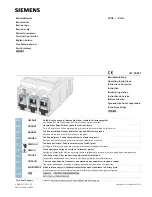
Multi LAN 350
Operation
44
Note:
The instrument continues testing if no remote is detected within 1s. In this case
the operator must ensure a proper cable termination.
The test can be run only on cables longer then 5m. A warning will be displayed in this
case.
5.3.14 DC Resistance
DC resistance test verifies that the loop resistances (sum of resistances of both wires)
in individual pairs are within the given limits.
Test procedure:
Make sure that the Remote unit is connected on the far end of the unit under test.
Select and start the Resistance test. After the Remote unit is connected and the test is
completed, the results, Pass/Fail information (if a limit is applied) and the limit are
shown on the display. The following actions can now be performed:
ESC key:
return to Single Test main screen
TEST:
repeat the test.
DC resistance result screen
Note:
If no remote is detected within 1s, the instrument continues with testing. In this
case the operator must ensure correct termination (shorts) at the cable end..
5.4 Scope functions
5.4.1 Background of TDR and TDnext
The Scope functions are powerful tools for troubleshooting and analysing cable
problems. They are based on the time domain representation of events on a line. After
transmission a pulse travels down the line (cable) and reflects back at the places where
anomalies occur. Anomalies can be caused by impedance mismatching, damaged
cable, incorrect termination or simply by an open or shorted cable end. On the base of
the shape of the reflected signal the anomaly reason can be found.
If the pulse propagation speed is known, the fault place can be easily located from the
time it takes the reflected pulse to return back to the transmitting end.
Two basic functions can be selected in SCOPE menu: TDR and TDnext.







































